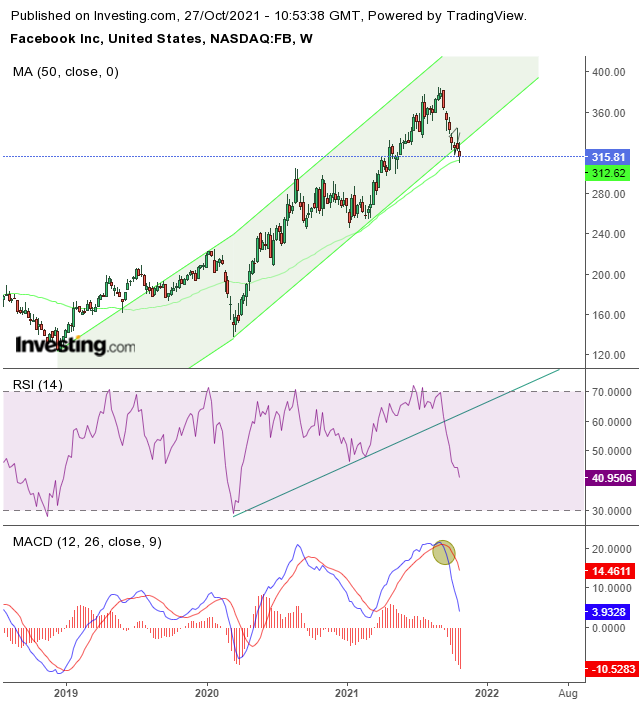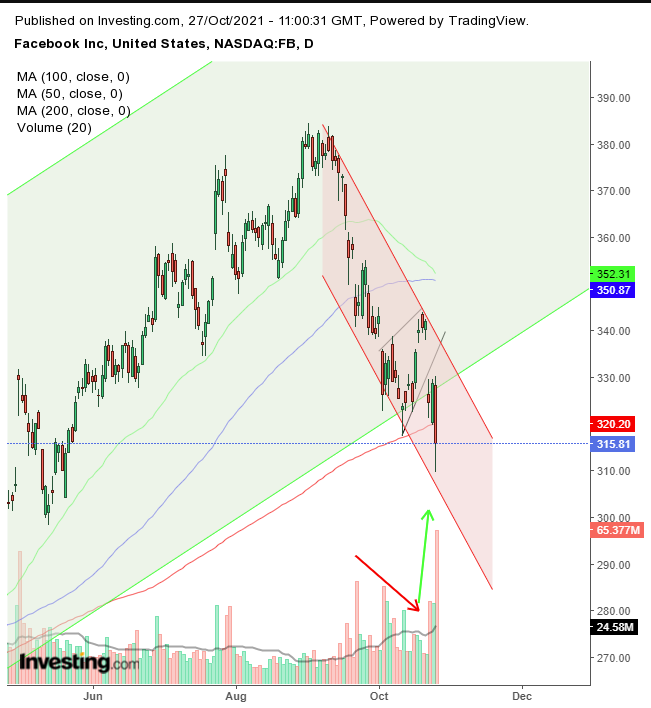After reporting earnings on Monday following the market close, Facebook (NASDAQ:FB) shares lost 5% on Tuesday.
The social media behemoth beat on earnings but came up short on revenue and average monthly user growth. The mammoth networking platform may be facing its most significant risk ever from the so-called "Facebook Papers." That's the collective designation for the plethora of information whistleblower Frances Haugen disclosed to the US Securities and Exchange Commission.
It contains hundreds of internal company documents including "presentations, research studies, discussion threads and strategy memos" illustrating how company executives "weigh[ed] trade-offs between public safety and their own bottom line."
Facebook has confronted whistleblower-fueled privacy scandals in the past, along with PR debacles and Congressional inquiries. But now the company is facing all these fundamental risks at once.
How badly will this pressure shares? Here's what the technicals are indicating:

The stock has fallen out of its rising channel since the March 2020 bottom. Note how the channel's top was a support during the 2018 bottom and the mid-2019 low, but once the price fell through the line, it turned to resistance starting August 2019.
Both the MACD and the RSI have provided negative crosses. For now, the 50-week MA is delivering support. A closer look provides additional, mostly gloomy detail:

On the daily chart it's clear the stock's drop below the rising channel was helped by a rising, bearish flag. Note how the volume dried out during the upward-slanting formation, demonstrating there was no support for a proper rally, but the price spiked amid the downside breakout.
After the price found resistance by the rising channel, it fell below the 50 DMA for the first time since March, when it did so only briefly. However, the price has remained above the 200 DMA since it climbed back in May, following the March 2020 bottom.
Are traders now disgusted enough with Facebook policies to break beneath the 200 DMA this time?
Trading Strategies
Conservative traders should wait for a return move to verify pattern integrity before risking a short.
Moderate traders would wait for the same corrective rally for a better entry, if not for confirmation.
Aggressive traders could short at will, provided they accept the risk proportionate to the higher gain of beating other traders to the punch.
Money management is critical. Here's an example:
Trade Sample - Short Position
- Entry: $325
- Stop-Loss: $330
- Risk: $5
- Target: $300
- Reward: $25
- Risk:Reward Ratio: 1:5
Author's Note: This above is just a sample, not the complete analysis. For that, you'd have to read the full post. Moreover, we're not fortune tellers. Professional trading is about "luck management," wherein the trader aims to use previously successful statistics to profit in the long run. Till you learn how to customize your trading plan, feel free to use ours, but for educational purposes, not for profit—or you'll end up with neither. Guaranteed.
